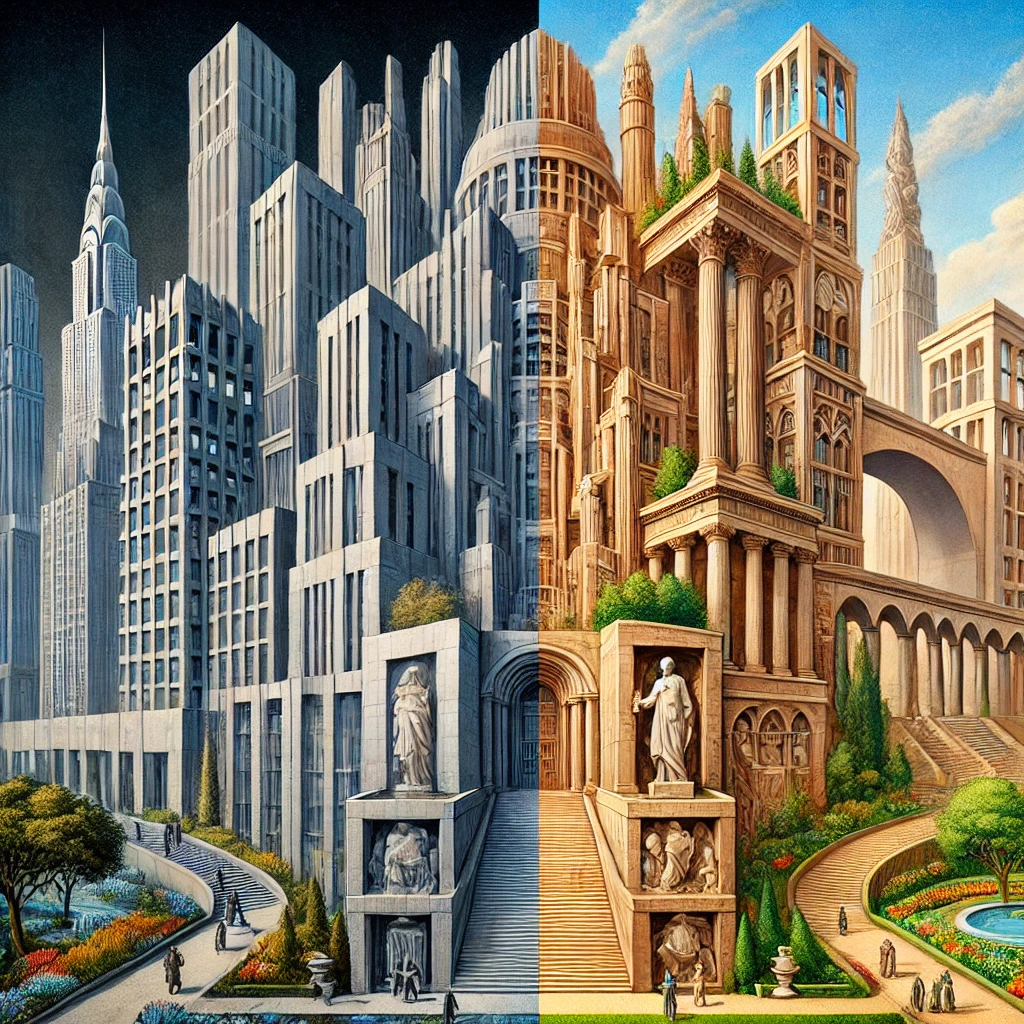The evolution of modern architecture offers a fascinating lens through which we can examine the intersection between the Royal Arts (with their focus on power, control, and symbolism) and the Liberal Arts (which emphasize beauty, ethics, and human flourishing). The absence of the ideals championed by the Liberal Arts in much of contemporary architecture has had profound effects on how we experience urban environments and how architecture shapes our societal structures.
1. Modern Architecture and the Royal Arts
In many ways, modern architecture—particularly its brutalist and functional forms—reflects the ideals of technocratic power and control, which we can link to the Royal Arts. Large government buildings, corporate towers, and financial centers are often designed to project a sense of authority and dominance, not unlike the ancient symbols of power used by royal dynasties or secret societies.
- Symbolism of Power: Much like the symbolism in the Royal Arts, modern architecture often employs forms and shapes that convey strength and control. For example, high-rise corporate buildings, with their towering and reflective surfaces, suggest impenetrability and secrecy, much as the obelisks and pyramids of ancient civilizations symbolized the power of the few over the many. This symbolism is aligned with the idea that those who control the spaces also control the social and economic structures within them.
- Imposing Structures: Architectural elements like sharp angles, brutalist concrete, and massive facades can create a sense of awe or submission, emphasizing the distance between the individual and the institution. These structures often lack human scale and emphasize the might of institutions rather than the needs or comfort of individuals. This reflects the esoteric principles of the Royal Arts, which focus on hierarchies and maintaining elite control over both physical and symbolic spaces.
2. Liberal Arts: The Missing Element in Modern Architecture
On the other hand, the Liberal Arts, with their focus on aesthetics, humanism, and ethics, are often neglected in modern architecture, especially in urban environments dominated by efficiency and utility. When architecture disregards these principles, we see a loss of beauty, community engagement, and a sense of belonging.
- Loss of Beauty and Human Connection: The absence of the “schone” (the beautiful) in much of modern architecture results in spaces that feel cold, alienating, and often inhospitable to the human spirit. The Liberal Arts would advocate for designs that are inspiring, harmonious, and connected to the human experience, encouraging beauty that resonates with our emotional and intellectual needs. This lack is evident in the industrialized and monolithic structures that dominate many urban landscapes.
- Ethical Concerns: From an ethical perspective, the functionality-first approach of much modern architecture often overlooks the impact on local communities and the environment. The good, in terms of human well-being and sustainability, is sacrificed for the sake of efficiency, leading to social issues such as gentrification, displacement, and a lack of access to green spaces. Liberal Arts would encourage architects to consider the needs of individuals and communities in the design process, creating spaces that foster well-being, inclusivity, and connectedness.
3. Consequences of the Liberal Arts’ Absence
The sidelining of the Liberal Arts’ principles in modern architecture has led to several significant consequences:
- Urban Alienation: Many urban spaces, dominated by glass, steel, and concrete, create a sense of alienation among inhabitants. Without attention to human scale and aesthetic harmony, these environments can feel disconnected from human needs for beauty and communal interaction. This fosters a sense of isolation and even anxiety, as people feel more like cogs in a machine than participants in a thriving, interconnected community.
- Loss of Spiritual Connection: The Liberal Arts teach that architecture can and should create a spiritual connection between individuals and their environment. This connection is often absent in utilitarian buildings, which focus on function at the expense of form. When architecture neglects the good, beautiful, and true, people are less likely to feel inspired by their surroundings, leading to a diminished sense of purpose or transcendence in daily life.
- Environmental and Ethical Oversights: Modern architecture’s focus on efficiency often comes at a cost to both the environment and social equity. The Liberal Arts, with their emphasis on ethical reflection, would challenge architects and urban planners to consider how building practices impact local ecosystems, energy consumption, and community integrity. The lack of such considerations has contributed to the spread of unsustainable urban sprawl, which exacerbates environmental degradation and social inequality.
4. A Path Forward: Reintegrating the Liberal Arts
To overcome the shortcomings of modern architecture, we must reintegrate the Liberal Arts into the design and planning process. This would involve:
- Designing with Aesthetics and Harmony in Mind: Architects should strive to create buildings that are not just functional but beautiful and in harmony with their surroundings. Drawing inspiration from classical architecture, where form and function were in balance, modern designs could incorporate natural materials, organic shapes, and green spaces to reconnect people with nature and themselves.
- Human-Centered Design: Liberal Arts promote a human-centered approach to architecture that prioritizes comfort, community, and engagement. This could mean designing spaces that foster social interaction, such as public plazas, parks, and cultural centers, and creating buildings that people feel connected to on a personal level.
- Sustainability and Ethics: Ethical reflection from the Liberal Arts can guide architects to consider the long-term impacts of their work, emphasizing sustainable building practices and the social implications of architectural decisions. This would involve creating spaces that are inclusive, accessible, and ecologically responsible, balancing the needs of the present with those of future generations.
Conclusion: Bridging Royal Arts and Liberal Arts in Architecture
The tension between the Royal Arts and Liberal Arts is evident in modern architecture, where the focus on power and utility often overshadows the humanistic principles of beauty, ethics, and community. The consequences of this imbalance are felt in alienating urban environments, unsustainable practices, and a loss of spiritual connection between people and their surroundings.
By reintroducing the Liberal Arts into architectural theory and practice, we can move toward designs that are not only functional but also inspiring, ethical, and sustainable—restoring the balance between power and beauty and creating environments that foster human flourishing. This synthesis would help create urban spaces that are truly holistic, blending the best of both worlds.




